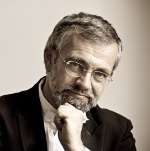Less than a year after Barrie Kosky’s brilliantly over-the-top direction of The Nose, Shostakovich's satirical first opera, Opera Australia premiered another brutally in-your-face production: Berg's Wozzeck, directed by South African William Kentridge. Welcome to Regietheater (or “director’s opera”, often used in a negative sense) at its best, presenting the social and artistic context of a work in a highly individual way, which in this case, while occasionally changing some of the composer’s intentions, never loses focus in its interpretation of the music and story of the opera.
First and foremost, Kentridge is a visual artist, with considerable experience in directing opera. His operatic credits include productions for the Metropolitan Opera, Opéra de Lyon and English National Opera. He also currently has an exhibition at the Art Gallery of NSW in Sydney. His persuasive interpretation of Berg’s antihero, Wozzeck, with his sufferings and humiliation, sins and hallucinations, adds a powerful visual concept, a fourth dimension, to traditional staging.
Kentridge’s Wozzeck (a co-production with the Salzburg Festival, Metropolitan Opera and Canadian Opera Company) reeks of the miserable, petty, dehumanised, betrayed and pungently tragic life of its protagonists. There are few characters on stage who could even be pitied or sympathised with, and no one is lovable. The only person who could symbolise innocence and a happier future – the bastard child of Wozzeck and Marie – is portrayed by a gas mask-clad puppet. There is no good solution for staging the little boy, says the director in the programme, and indeed, his does not appear to suggest one either. This tiny role could gain huge significance in the final minutes of the opera, but no catharsis can be reached by a puppet sitting on a wooden horse, singing “hopp-hopp” to himself.
Clearly, the new element that Kentridge brings to our understanding of Wozzeck is his single-minded obsession with war being the cause of all the desolation in this work. His tragic and fully credible statement is that human malice makes war possible, while war inexorably brings with it human malice.
Flashes of barbed wire fences, barren fields, crashed airplanes, war maps, searching spotlights, severed heads and gas masks fill not only Wozzeck’s tormented visions (in our times, he would probably be diagnosed as a victim of Post Traumatic Stress Disorder), but also the entire stage and its backdrop, as relentless video projections. The excellent creative team, all long-term Kentridge collaborators, include projection designer Catherine Meyburgh, set designer Sabine Theunissen, co-director Luc de Wit and lighting designer Urs Schnönebaum.
These projections, showing signs of artistic kenophobia more than once, change rapidly, provoke thoughts and constantly occupy the audience’s mind. While they always support the action and often express the protagonists’ inner thoughts in a sublimated way, these animated sketches, recurring visual motifs, charcoal drawings (many of them drawn by Kentridge himself, reminiscent of George Grosz’s work) and surrealistic film footages are in danger of attracting too much of the audience’s attention and sometimes – on purpose – completely bleach out everyone and everything on stage. Most of the time though, they ingeniously reflect often minute details of the text; for example, the image of whole stage changes abruptly when Wozzeck first utters his significant “Wir arme Leut” (or “us, poor people”).
Thus, Kentridge’s use of video technology creates another, highly complex, visual score next to Berg’s sonic one and the two are performed simultaneously. However, the singers seemed to get slightly less attention in this process, as they fumbled their way on crooked platforms, piles of chairs and broken staircases. The two protagonists, Michael Honeyman in the title role and Lorina Gore as Marie, nonetheless shone with assured vocal preparation and solid role characterisation. In all their shared scenes, they beautifully expressed the yearning to love and be loved, yet they are hardly ever in physical proximity. When on the other hand, the Drum-Major (John Daszak) seduces Marie, they do touch each other, yet their movements are almost parodistic and lack sensuality.
Berg’s musical language in this work regularly mixes ordinary singing with Sprechstimme, speaking melody with a clearly described rhythmical declamation. This creates vocal challenges that are mostly met by the rest of the cast. The Captain’s part often bursts into falsetto, and his heinous laughter follows a precise rhythm, all ably presented by John Longmuir. Richard Anderson, in the role of the Doctor, Wozzeck’s other tormentor, provided all his medical nonsense with great stage presence and reliable singing.
Andrea Molino, a regular visitor to Opera Australia, conducted the performance with clear gestures and empathy, contributing greatly to a musically tight performance. The orchestra’s sound under his baton was warm and responsive. Individual solos were confident and could be well heard, although the recently introduced gentle amplification of the musicians at times was less than subtle.




